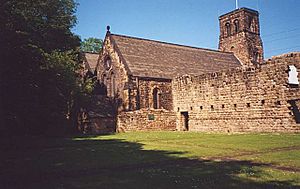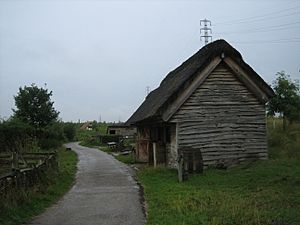Jarrow Hall (museum) facts for kids
| Established | 1993 |
|---|---|
| Location | Jarrow, South Tyneside, England |
Jarrow Hall is a special museum in Jarrow, South Tyneside, England. It used to be called Bede's World. This place celebrates the life of a very important monk named the Venerable Bede. He was a writer and a scholar who lived a long time ago. Bede lived at the Abbey Church of Saint Peter and Saint Paul, which was a big monastery in Jarrow and Monkwearmouth.
The museum shows you what life was like during Bede's time. You can explore a reconstructed Anglo-Saxon farm. There is also an old 18th-century building called Jarrow Hall House. The museum often has fun activities, special events, and workshops. It's a great place to learn about history.
Contents
Jarrow Hall's History
How Bede's World Started
The Anglo-Saxon museum, Bede's World, first opened in Jarrow in 1993. It was built on a large 11-acre site. The museum aimed to teach people about Anglo-Saxon life. It was managed by a charity called the Bede's World Charitable Trust.
Why the Museum Closed
Even though many people visited Bede's World each year, it became too expensive to run. The museum closed down in February 2016. Many people were sad about this, including the writer Melvyn Bragg. He thought it was a shame that such an important historical site had to close.
Reopening as Jarrow Hall
A New Beginning
Good news came in August 2016! It was announced that the museum would reopen. It got a new name: 'Jarrow Hall Anglo-Saxon Farm, Village and Bede Museum'. A charity called Groundwork's South Tyneside and Newcastle trust took over its management.
The Grand Relaunch
Groundwork invested a lot of money to make the site even better. Jarrow Hall officially reopened on April 8, 2017. They had many exciting activities for everyone. Visitors could enjoy farm talks and watch live re-enactment combat. There were also workshops where you could learn Anglo-Saxon crafts.
The old historical buildings were fixed up using traditional methods. Workers dressed in old clothes used "wattle and daub" to repair them. This is an ancient building technique using woven sticks and mud. The inside of Jarrow Hall House was also updated. It now has a coffee shop called Hive Coffee Company.
What You Can See at Jarrow Hall Today
The Bede Museum
The main Bede Museum building has an exhibit called "Age of Bede." Here, you can see real objects found from the old monastery. These include pieces of stained glass, old pottery, and ancient coins. The exhibits teach you about Anglo-Saxon culture. You can also learn about Bede's life and his writings. There are displays about what it was like to be a monk. You can also discover the history of the medieval Kingdom of Northumbria.
The Anglo-Saxon Farm
Jarrow Hall has a working Anglo-Saxon farm called Gyrwe. This name comes from the Old English name for Jarrow. The farm shows how people lived and raised animals long ago. There are three large wooden buildings that look like real Anglo-Saxon homes. These buildings were built using old techniques.
One building, Thirlings Hall, was the largest. It had animal hides and other items inside. A small fire pit is used there, making the building smell like wood smoke. The other two buildings are smaller. One is a grubenhaus, which is a sunken building used for cold storage. The other is a monk's cell, a small room where a monk would live. All these buildings have thatched roofs.
Farm Animals and Plants
The farm animals at Jarrow Hall are special. They are similar to the types of animals that lived about 1300 years ago. This helps visitors imagine what Anglo-Saxon England was like. For example, the cattle are smaller than modern cows. The sheep breeds are more varied. This is because selective breeding methods were not common back then. In the past, ancient types of wheat and vegetables were also grown on the farm. These were the kinds of foods monks might have eaten.
Monastery Ruins and Gardens
You can also visit the ruins of the Anglo-Saxon monastery of St Paul. This site is very important and is protected as a "scheduled monument." This means it's a nationally important historical place.
Next to the Bede Museum is Jarrow Hall House. This is an 18th-century Georgian building. It has a coffee shop where you can relax. Behind Jarrow Hall House, there is a medieval herb garden. This garden has over 200 different kinds of herbs. There is also a gift shop inside the Bede Museum. Jarrow Hall also hosts events and conferences in its buildings.



